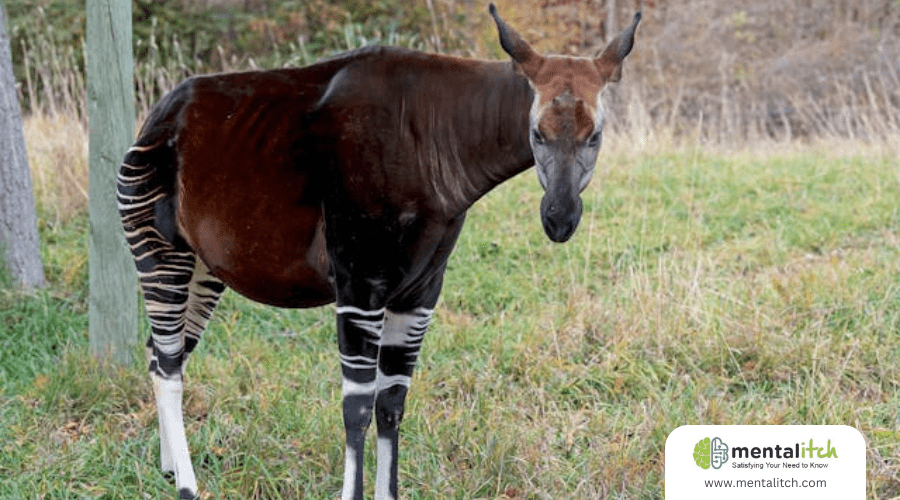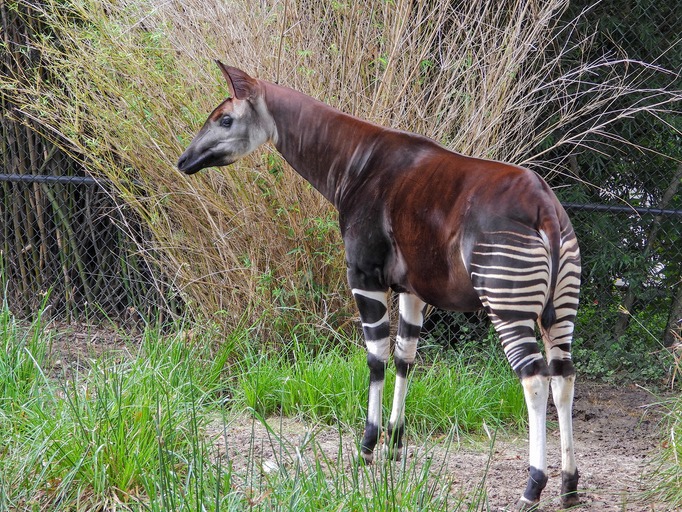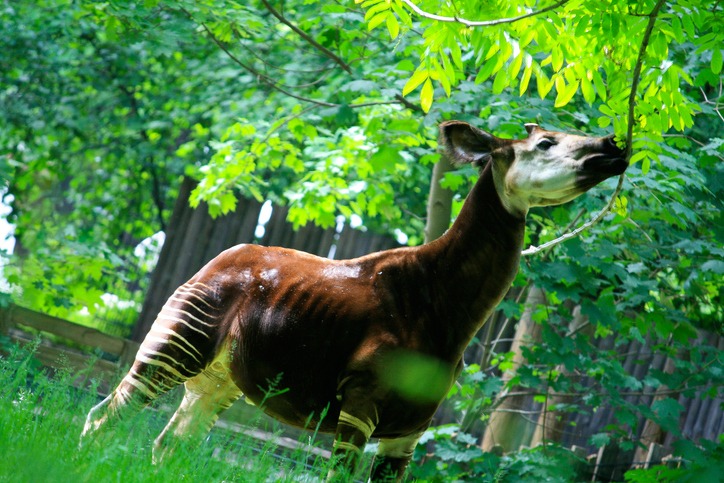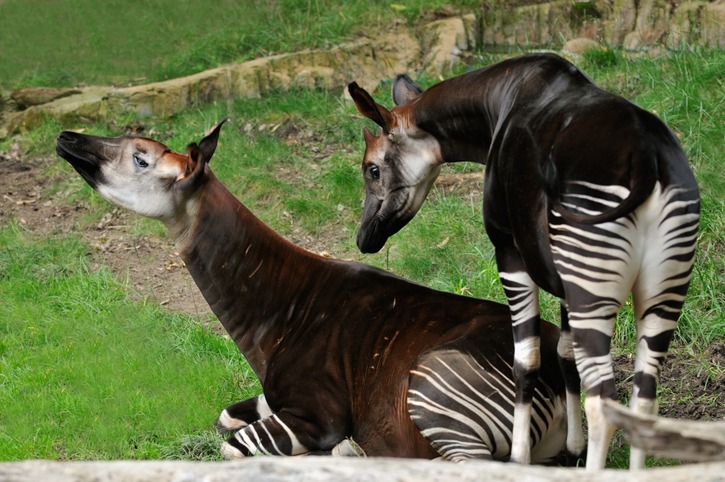The okapi is a unique animal found in dense forests. It’s distinguished by its fur and zebra-like stripes on its back. This animal stands out as one of nature’s most intriguing designs. Its specialized diet and unique communication methods further highlight its fascinating adaptations. Discover how this creature has evolved to thrive in its environment.
Overview of the Okapi
At first look, you may assume okapis are related to zebras because of the stripes on their legs. Yet, despite the similarity, the two are not closely related. They even belong to different taxonomic orders: Okapis are even-toed ungulates (a broad group that includes most hoofed mammal species), while zebras are odd-toed ungulates (along with horses, rhinos, and tapirs).
Looking closely at the animal’s head, you may notice another resemblance — the giraffe. Okapis are the only surviving members of the giraffe family who aren’t giraffes. They are the lone species in the genus Okapia, which joins Giraffa as the two extant genera in the family Giraffidae.
The okapi inhabits the dense forests of the Democratic Republic of the Congo, primarily the Ituri Rainforest. Its zebra-like stripes help it blend into the forest’s dappled light and shadows. While it shares similarities with the giraffe, it has unique adaptations for its forest environment, such as an 18-inch long tongue for grasping leaves, twigs, and fruits. They consume 40 to 65 pounds of vegetation daily.
They communicate using scent glands on their feet, urine spraying, and low-frequency calls. Conservation efforts are crucial as they face threats from hunting and habitat loss. Protecting them is essential for preserving the Congo’s diverse ecosystem.
Habitat and Distribution
The Ituri Forest, a World Heritage site, underscores its global ecological importance and serves as the sole habitat for the okapi. Efforts like the Okapi Conservation Project and wildlife protection laws are essential for safeguarding this endangered species. The International Union for Conservation of Nature (IUCN) has listed the okapi as endangered, recognizing its vulnerability.
Key points about the okapi’s habitat and distribution include:
- Exclusive Habitat: The okapi is found solely in the Ituri Forest, emphasizing the need for targeted conservation efforts in this region.
- Okapi Wildlife Reserve: This dedicated area within the Ituri Forest aims to protect the okapi and other wildlife from poaching and habitat destruction.
- Conservation Challenges: Despite being a protected area, the Ituri Forest faces ongoing threats from illegal logging and mining activities.
Unique Physical Features
Okapis possess a range of fascinating physical adaptations that enhance their survival in the dense rainforest. One of the most striking features is their hindquarters stripes, which provide excellent camouflage by blending seamlessly with the forest’s patterned shadows. This adaptation also helps them evade predators.
They have smooth, thick, and oily fur that repels water effectively in their humid rainforest habitat, ensuring they stay dry. Males have short horns called ossicones, which are covered with skin and used in dominance displays.
Okapis also have specialized scent glands located on their hooves. They use it for territorial marking. This helps them communicate and establish boundaries within their range. Another remarkable feature is their prehensile tongues which allow them to grasp leaves and branches easily and aid in grooming.
Summary of Unique Features
| Feature | Description | Function |
| Hindquarters Stripes | Provide camouflage | Evade predators |
| Velvety Fur | Thick, oily, water-repellent | Stay dry |
| Short Horns | Skin-covered ossicones | Dominance displays |
| Scent Glands | Located on hooves | Territorial marking |
| Prehensile Tongue | Long and flexible | Grasping leaves and grooming |
Behavior and Diet
Okapis lead solitary lives and are most active during the day, adapting well to their dense rainforest habitat with keen senses and a specialized diet. They prefer solitude, interacting with other okapis mainly during mating periods. They are herbivores that primarily feed on leaves, fruits, and grasses. Their long, flexible tongues allow them to strip leaves from branches, consuming a variety of vegetation. This specialized diet ensures they obtain the necessary nutrients to thrive.
To establish and maintain their territory, okapis mark boundaries by spraying urine and secreting a black substance from glands on their feet. This behavior helps them avoid confrontations with other okapis and supports their solitary lifestyle.
Key points about okapi behavior and diet:
- Behavior: Solitary, territorial, and primarily diurnal.
- Diet: Herbivorous, feeding on leaves, fruits, grasses, and fungi.
- Adaptations: Keen senses and specialized feeding habits for rainforest survival.
Reproduction and Family Life
Female okapis give birth to a single calf after a gestation period of 14 to 16 months. Upon birth, the calf can stand and nursing within hours, ensuring it receives the essential nutrients for survival. To protect her calf from predators, the mother hides it in dense foliage. This hiding period lasts until the calf gains enough strength to follow its mother.
At around three weeks old, the calf begins to eat solid food and grows rapidly, tripling its size by the end of its second month. This swift growth is crucial for its survival and keeping pace with its mother. During this period, the bond between the mother and calf remains strong.
They also possess a unique communication system that includes low-frequency calls. These calls allow the mother and calf to stay connected, even without visual contact. This sophisticated communication ensures the calf’s safety and enables it to receive guidance from its mother.
The family life of okapis revolves around nurturing and protecting the young, preparing them for the challenges of the wild.
Conservation Efforts
The survival of okapi calves heavily depends on their mothers, making the conservation of their natural habitat crucial. The Okapi Conservation Project, established in 1987, focuses on the Okapi Wildlife Reserve in the Democratic Republic of the Congo. Rangers patrol the reserve to prevent poaching and habitat destruction, creating a safer environment for these endangered animals.
Collaboration is essential for the success of these initiatives. By working with the Institut Congolais pour la Conservation de la Nature (ICCN) and the International Union for Conservation of Nature (IUCN), the Okapi Conservation Project implements strategic measures to protect the okapi population. These partnerships are vital for sharing resources and knowledge, enhancing conservation efforts.
Key actions in these conservation efforts include:
- Patrols and Protection: Rangers routinely patrol the Okapi Wildlife Reserve to combat poaching and monitor habitat conditions.
- Community Involvement: Engaging local communities in conservation efforts to ensure long-term protection and sustainable practices.
- Research and Monitoring: Conducting ongoing research and monitoring to understand okapi behavior and habitat needs, guiding future conservation strategies.
Conclusion
The okapi stands out as one of nature’s most intriguing creations with its unique physical traits, solitary behavior, and specialized diet. This forest dweller, the last living relative of the giraffe, thrives in the dense rainforests of the Democratic Republic of the Congo. Conservation efforts are crucial to protect this endangered species from habitat loss and hunting.



